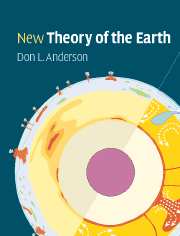Book contents
- Frontmatter
- Contents
- Preface and Philosophy
- Abbreviations and acronyms
- Part I Planetary perspective
- Part II Earth: the dynamic planet
- Part III Radial and lateral structure
- Part IV Sampling the Earth
- Chapter 12 Statistics and other damned lies
- Chapter 13 Making an Earth
- Chapter 14 Magmas: windows into the mantle
- Chapter 15 The hard rock cafe
- Chapter 16 Noble gas isotopes
- Chapter 17 The other isotopes
- Part V Mineral physics
- Part VI Origin and evolution of the layers and blobs
- Part VII Energetics
- References and notes
- Appendix
- Index
Chapter 13 - Making an Earth
Published online by Cambridge University Press: 05 June 2012
- Frontmatter
- Contents
- Preface and Philosophy
- Abbreviations and acronyms
- Part I Planetary perspective
- Part II Earth: the dynamic planet
- Part III Radial and lateral structure
- Part IV Sampling the Earth
- Chapter 12 Statistics and other damned lies
- Chapter 13 Making an Earth
- Chapter 14 Magmas: windows into the mantle
- Chapter 15 The hard rock cafe
- Chapter 16 Noble gas isotopes
- Chapter 17 The other isotopes
- Part V Mineral physics
- Part VI Origin and evolution of the layers and blobs
- Part VII Energetics
- References and notes
- Appendix
- Index
Summary
Thus God knows the world, because He conceived it in His mind, as if from the outside, before it was created, and we do not know its rule, because we live inside it, having found it already made.
Brother William of BaskervilleOverview
Attempts to estimate mantle composition fall into two broad categories.
Cosmochemical approaches take meteorites as the basic building blocks; these materials are processed or mixed in order to satisfy such constraints as core size, heat flow and crustal ratios of certain elements. These models constrain the bulk chemistry of the Earth rather than that of the mantle alone. The only primitive meteorites that match satisfactorily both the stable isotope and redox characteristics of the Earth are the enstatite chondrites. The actual material forming the Earth is unlikely to be represented by a single meteorite class. It may be a mixture of various kinds of meteorites and the composition may have changed with time. The oxidation state of accreting material may also have changed with time.
Petrological models take the present continental crust, basalts and peridotites as the basic building blocks. Since basalts represent melts, and peridotites are thought to be residues, some mixture of these should approximate the composition of the upper mantle. Peridotites are the main mantle reservoirs for elements such as magnesium, chromium, cobalt, nickel, osmium and iridium. The continental crust is an important reservoir of the crustal elements; potassium, rubidium, barium, lanthanum, uranium and thorium. Enriched magmas, such as kimberlites, are rare but they are so enriched in the crustal elements that they cannot be ignored.
- Type
- Chapter
- Information
- New Theory of the Earth , pp. 153 - 167Publisher: Cambridge University PressPrint publication year: 2007



